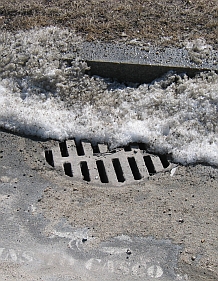Causal Analysis of Biological Impairment in Long Creek, a Sandy-Bottomed Stream in Coastal Southern Maine (Final Report)
Federal Register Notices
Contact
- Rick Ziegler
- by phone at: 703-347-8554
- by email at: ziegler.rick@epa.gov
- by email at: ziegler.rick@epa.gov
Notice
EPA annnounces the release of the Causal Analysis of Biological Impairment in Long Creek: A Sandy-Bottomed Stream in Coastal Southern Maine final document on December 13, 2007.
This assessment presents results from a complex causal assessment of a biologically impaired, urbanized coastal watershed located primarily in South Portland, Maine, USA—the Long Creek watershed. This case study serves as an example implementation of U.S. Environmental Protection Agency Stressor Identification (SI) guidance (http://www.epa.gov/caddis/).Background
 The primary goals of the Long Creek case study include: 1) to serve as an example United States Environmental Protection Agency Stressor Identification (SI) case study, whereby the report may help future assessors understand the SI process for other biologically impaired ecosystems, and may help the broader scientific community better understand urban-related stressor interactions, and 2) to provide useful information for the improvement of the Long Creek watershed; this is especially timely, as stakeholders are currently considering options for promoting ecological recovery of the watershed.
The primary goals of the Long Creek case study include: 1) to serve as an example United States Environmental Protection Agency Stressor Identification (SI) case study, whereby the report may help future assessors understand the SI process for other biologically impaired ecosystems, and may help the broader scientific community better understand urban-related stressor interactions, and 2) to provide useful information for the improvement of the Long Creek watershed; this is especially timely, as stakeholders are currently considering options for promoting ecological recovery of the watershed.History/Chronology
| Mar 2006 | EPA sends out the draft document for EPA internal review. |
| Sep 2006 | EPA releases the draft document for an External Peer Review. |
| Dec 2007 | EPA publishes the final document to the NCEA Web site. |
Next Steps
This is the Final document.
Downloads/Related Links
- Causal Analysis of Biological Impairment in Long Creek: A Sandy-Bottomed Stream in Coastal Southern Maine (PDF) (224 pp, 6 MB, about PDF)
- Causal Analysis of Biological Impairment in Long Creek
Related Link(s)
Citation
U.S. EPA. Causal Analysis of Biological Impairment in Long Creek, a Sandy-Bottomed Stream in Coastal Southern Maine (Final Report). U.S. Environmental Protection Agency, Washington, DC, EPA/600/R-06/065F.
![[logo] US EPA](https://webarchive.library.unt.edu/eot2008/20081106095328im_/http://www.epa.gov/epafiles/images/logo_epaseal.gif)
